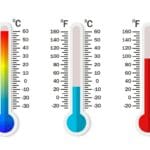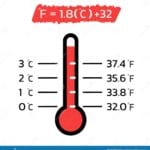If you’re curious about what 36.6 Celsius is in Fahrenheit, then you’re in the right place. Just click on the link to find out. 36.6 celsius to fahrenheit
Decoding 36.6°C: What Does This Temperature Mean?
Let’s unravel the mystery of 36.6°C. This temperature, equivalent to 97.88°F, sits comfortably within the range of what’s typically considered a normal body temperature for adults. However, it’s crucial to remember that “normal” body temperature isn’t a fixed point. It can fluctuate throughout the day, influenced by factors like activity levels, diet, time of day, and even age. A slightly lower temperature in the morning and a slight rise in the evening is a natural ebb and flow.
Converting Celsius to Fahrenheit: A Simple Guide
Switching between Celsius and Fahrenheit is like translating languages for temperature. The formula to unlock the Fahrenheit equivalent of a Celsius temperature is: °F = (°C x 9/5) + 32. Let’s apply this to 36.6°C:
(36.6 x 9/5) + 32 = 65.88 + 32 = 97.88°F
To illustrate further, here are a few other conversions:
- 0°C = 32°F (freezing point of water)
- 100°C = 212°F (boiling point of water)
- 20°C = 68°F (a comfortable room temperature)
Is 36.6°C a Fever?
A common question arises: Is 36.6°C (97.88°F) a fever? The answer is likely no. Medical professionals generally define a fever as a body temperature of 100.4°F (38°C) or higher. Therefore, 36.6°C falls below the fever threshold. Some experts suggest a broader “normal” range, spanning from about 36.1°C (97°F) to 37.2°C (99°F). This accommodates the natural variations we’ve discussed.
Understanding Normal Body Temperature: A Range, Not a Number
While 36.6°C is often cited as a standard, individual baseline temperatures can vary. What’s normal for one person might be slightly high or low for another. Factors like age, activity level, and overall health can influence body temperature. Ongoing research continues to explore these nuances and their impact on our well-being. Some studies suggest that even slight deviations from the “normal” range may indicate underlying health conditions, though more research is needed.
When to Consult a Doctor
Although 36.6°C is likely not a fever, it’s crucial to listen to your body. If you’re feeling unwell, have other symptoms like chills, aches, or a persistent elevated temperature, consult a healthcare professional. They can provide personalized advice based on your individual situation.
Beyond Body Temperature: Why Conversion Matters
Beyond health, Celsius-Fahrenheit conversion is essential in diverse areas:
- Travel: Interpreting weather forecasts accurately can significantly impact your travel plans.
- Scientific Research: Precise temperature measurements and conversions are fundamental for accurate scientific findings.
- Cooking: Some recipes use Celsius, others Fahrenheit. Accurate conversion can be the difference between a culinary success and a disaster.
Quick Conversion Methods
Several handy tools simplify temperature conversion:
- Online Converters: Instantly convert Celsius to Fahrenheit and vice-versa.
- The Formula: °F = (°C x 9/5) + 32 offers a reliable method for manual conversion.
- Conversion Charts: While less precise, these charts offer a quick visual guide.
Taking Your Temperature: Methods and Considerations
How you take your temperature influences the reading. Common methods include:
| Method | Typical Range (°C) |
|---|---|
| Oral | 36.1 – 37.2 |
| Axillary (Armpit) | Typically 0.3-0.6°C lower than oral |
| Rectal | Typically 0.3-0.6°C higher than oral |
| Tympanic (Ear) | Similar to rectal |
It’s important to use the same method consistently and be aware of these potential variations.
Basal Body Temperature (BBT)
Basal body temperature (BBT) represents the lowest body temperature attained during rest. Tracking BBT can be particularly useful for women monitoring ovulation cycles and trying to conceive. While a typical BBT can vary, it’s often slightly lower than the standard “normal” body temperature. More research is needed to further understand the nuances of BBT and its correlation to overall health.
Age and Body Temperature
Normal body temperature can also differ slightly based on age:
- Infants and Children: Tend to have slightly higher average body temperatures than adults.
- Older Adults: May have slightly lower average temperatures.
It’s important to consider these age-related variations when interpreting temperature readings.
Debunking Fever Myths
Some common misconceptions exist regarding fevers:
- Myth: All fevers are harmful and require immediate treatment.
Reality: Fever is often a natural defense mechanism, helping the body fight infection. However, high fevers or fevers lasting more than a few days warrant medical attention.
Myth: Forehead thermometers are as accurate as other methods.
- Reality: While convenient, forehead thermometers can be less precise than oral, rectal, or tympanic measurements.
The Bottom Line
Understanding body temperature and the Celsius-Fahrenheit conversion empowers you to interpret temperature readings accurately and make informed decisions regarding your health. While 36.6°C (97.88°F) is generally considered within the normal range, individual variations exist. Remember, listening to your body and seeking professional medical advice when needed are always the best courses of action.













1 thought on “36.6 Celsius to Fahrenheit: Understanding the Conversion and its Meaning”
Comments are closed.